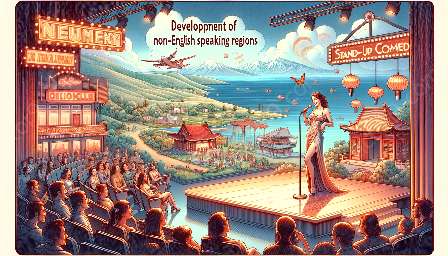Stand-up comedy has a rich history and diverse culture, with non-English speaking regions contributing significantly to its development. One fascinating aspect of stand-up comedy in these regions is the use of non-verbal comedy techniques. This article will delve into the development of stand-up comedy in non-English speaking regions, explore the unique non-verbal comedy techniques employed by comedians, and discuss the impact of physical humor on the comedy scene.
Development of Stand-up Comedy in Non-English Speaking Regions
Stand-up comedy has experienced a global surge in popularity, transcending linguistic and cultural boundaries. In non-English speaking regions, stand-up comedy has evolved in distinctive ways, reflecting the local traditions, language, and societal norms. Comedians from non-English speaking regions have carved out their own comedic styles, creating a vibrant and diverse comedy landscape.
Impact of Culture and Language
The development of stand-up comedy in non-English speaking regions is intricately intertwined with the local culture and language. Comedians often draw on cultural references, societal norms, and everyday experiences that resonate with their audiences. This localized approach has led to the emergence of unique comedic voices, offering audiences a refreshing perspective on humor and entertainment.
Non-Verbal Comedy Techniques
While language plays a central role in stand-up comedy, non-English speaking comedians have adeptly utilized non-verbal comedy techniques to captivate audiences. Non-verbal comedy encompasses a wide range of physical humor, gestures, and expressions that transcend language barriers, eliciting laughter and amusement from diverse audiences.
Physical Comedy and Expressions
Comedians in non-English speaking regions often rely on physical comedy to convey humor and connect with their audience. Expressive facial expressions, exaggerated gestures, and comedic movements serve as potent tools for eliciting laughter. This form of non-verbal communication allows comedians to transcend linguistic barriers and create a universal comedic experience.
Impact of Non-Verbal Comedy
The use of non-verbal comedy techniques has significantly contributed to the evolution of stand-up comedy in non-English speaking regions. Comedians have harnessed the power of physical humor to engage with diverse audiences, fostering greater inclusivity and transcending linguistic limitations. Non-verbal comedy techniques have not only enhanced the comedic repertoire but also showcased the universal appeal of humor, reinforcing the notion that laughter knows no linguistic boundaries.
Conclusion
Stand-up comedy in non-English speaking regions has flourished through the embrace of non-verbal comedy techniques. The development of stand-up comedy in these regions has been marked by the rich tapestry of cultural influences and the innovative use of physical humor. As the comedy scene continues to evolve, non-verbal comedy techniques will undoubtedly play a pivotal role in shaping the future of stand-up comedy, offering audiences a diverse and enriching comedic experience.
























